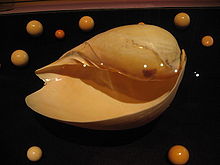Melo melo
| Indian volute | |
|---|---|
 |
|
| A shell of the Indian volute, Melo melo, with a group of Melo pearls | |
| Scientific classification | |
| Kingdom: | Animalia |
| Phylum: | Mollusca |
| Class: | Gastropoda |
| (unranked): | clade Caenogastropoda clade Hypsogastropoda clade Neogastropoda |
| Superfamily: | Muricoidea |
| Family: | Volutidae |
| Genus: | Melo |
| Species: | M. melo |
| Binomial name | |
|
Melo melo (Lightfoot, 1786) |
|
| Synonyms | |
|
Cymbium melo (Lightfoot, 1786) |
|
Cymbium melo (Lightfoot, 1786)
Voluta anguria Lightfoot, 1786
Melo indica (Gmelin, 1791)
Voluta indica Gmelin, 1791
Yetus indicus (Gmelin, 1791)
Cymbium maculatum Röding, 1798
Voluta citrina Fischer, 1807
Melo melo, common name the Indian volute or bailer shell, is a very large sea snail, a marine gastropod mollusc in the family Volutidae, the volutes.
The distribution of this species is restricted to Southeast Asia, from Burma, Thailand and Malaysia, to the South China Sea and the Philippines.
This large sea snail is known to live in littoral and shallow sublittoral zones. It usually dwells in muddy bottoms at a maximum depth of nearly 20 m.
Melo melo is known to be carnivorous, as laboratory experiments have shown. It is a specialized predator of other continental shelf predatory gastropods, notably Hemifusus tuba (Melongenidae) and Babylonia lutosa (Buccinidae). It is also a known predator of the dog conch, Strombus canarium (Strombidae).
The maximum shell length of this species is up to 275 mm, commonly to 175 mm.
The notoriously large shell of Melo melo has a bulbous or nearly oval outline, with a smooth outer surface presenting distinguishable growth lines. The outside of shell colour is commonly pale orange, sometimes presenting irregular banding of brown spots, while the interior is glossy cream, becoming light yellow near its margin. The columella has three or four long and easily distinguishable columellar folds. It has a wide aperture, nearly as long as the shell itself, yet this species is known to have no operculum. The shell's spire is completely enclosed by the body whorl, which is inflated and quite large, and has a rounded shoulder with no spines. The apex is of smooth type.
...
Wikipedia
